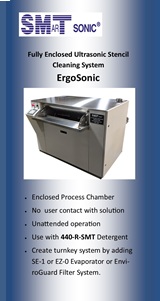|

|
|
| Ask the Experts | |||||||
|
|||||||
|
November 9, 2011 - Updated November 7, 2011 - Originally Posted Cleaning Reballed BGA ComponentsWe currently clean reballed BGA components using an ultrasonic cleaner with hot water and cleaning solution. The components are then baked at 100-120 deg c to remove any moisture. The components appear very clean after this process. Is this an acceptable practice for cleaning reballed BGA components? I. F. |
|||||||
| Expert Panel Responses | |||||||
|
A defluxing process consists of wash, rinse and drying cycles. In the below explanation, the client mentions that he used hot water and cleaning solution for washing these BGAs, however there is no information on whether they do the rinsing with heated deionized water before components go through the drying cycle. Is rinsing with DI water involved in this process? Visually clean is one thing, however one has to consider the ionic and non-ionic residues as well from electrical cleanliness standpoint. For ionic residues, has the ionic contamination test (ROSE test) or Ion chromatography test been performed on these parts? Additionally, SEM (Scanning Electron Microscope), EDS (Energy Dispersive Spectrometry) or FTIR (Fourier Transform Infrared Spectroscopy) tests could be performed. The components may have to also go through a functional performance test on a populated board to investigate if there would be any issues.
Application Technology Manager Zestron America Mr. Tosun has published numerous technical articles. As an active member of the SMTA and IPC organizations, Mr. Tosun has presented a variety of papers and studies on topics such as "Lead-Free Cleaning" and "Climatic Reliability".
Over the years of selling our reballing mini-oven, we have seen others using ultrasonic cleaners. The one caution is your "cleaning solution." I would do 2 things to be more confident about the quality of your reballed BGA:
Sales Director Finetech Neil O'Brien has worked in the field of electronic manufacturing equipment for over fifteen years and is currently Sales Director for Finetech, a manufacturer of precision rework systems and die bonders.
This is an acceptable proceedure as long as your baking time meets the requirements of the package that you are reballing.
Regional Sales Manager OK International Inc. Ed Zamborsky is a Regional Sales & Technical Support Manager for Thermaltronics, located in New York. His position requires frequent customer visits throughout North America and the Caribbean and his position encompasses not only sales but the role of trainer and master applications engineer for all of Thermaltronics products. His expertise includes such specialties as hand soldering, convection and conduction reflow techniques, array rework, fluid dispensing equipment, and fume extraction. Ed has authored many articles and has presented many papers on topics such as; Low Volume SMT Assembly, Solder Fume Extraction, SMT Rework, BGA Rework, Lead-Free Hand Soldering, High Thermal Demand Hand Soldering, Lead Free Visual Inspection and Lead Free Array Rework.
|
|||||||
| Submit A Comment | |||||||
|
Comments are reviewed prior to posting. You must include your full name to have your comments posted. We will not post your email address. |
|
Free Newsletter Subscription
Circuitnet is built for professionals who bear the responsibility of looking ahead, imagining the future, and preparing for it. Insert Your Email Address |
|

|





